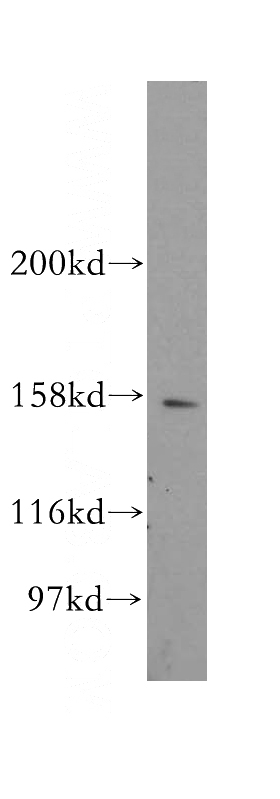-
Product Name
CENPJ antibody
- Documents
-
Description
CENPJ Rabbit Polyclonal antibody. Positive WB detected in mouse testis tissue. Positive IF detected in HepG2 cells. Observed molecular weight by Western-blot: 153kd
-
Tested applications
ELISA, WB, IF
-
Species reactivity
Human,Mouse,Rat; other species not tested.
-
Alternative names
BM032 antibody; CENP J antibody; CENPJ antibody; centromere protein J antibody; CPAP antibody; LAG 3 assOCiated protein antibody; LAP antibody; LIP1 antibody; LYST interacting protein 1 antibody; MCPH6 antibody
-
Isotype
Rabbit IgG
-
Preparation
This antibody was obtained by immunization of CENPJ recombinant protein (Accession Number: BC024209). Purification method: Antigen affinity purified.
-
Clonality
Polyclonal
-
Formulation
PBS with 0.1% sodium azide and 50% glycerol pH 7.3.
-
Storage instructions
Store at -20℃. DO NOT ALIQUOT
-
Applications
Recommended Dilution:
WB: 1:200-1:2000
IF: 1:10-1:100
-
Validations

mouse testis tissue were subjected to SDS PAGE followed by western blot with Catalog No:109254(CENPJ antibody) at dilution of 1:500

Immunofluorescent analysis of HepG2 cells using Catalog No:109254(CENPJ Antibody) at dilution of 1:25 and Rhodamine-Goat anti-Rabbit IgG
-
Background
CENPJ, also named as CPAP, LAP and LIP1, belongs to the TCP10 family. It plays an important role in cell division and centrosome function by participating in centriole duplication. CENPJ inhibits microtubule nucleation from the centrosome.
-
References
- Al-Hakim AK, Bashkurov M, Gingras AC, Durocher D, Pelletier L. Interaction proteomics identify NEURL4 and the HECT E3 ligase HERC2 as novel modulators of centrosome architecture. Molecular & cellular proteomics : MCP. 11(6):M111.014233. 2012.
- Kim MK, Dudognon C, Smith S. Tankyrase 1 regulates centrosome function by controlling CPAP stability. EMBO reports. 13(8):724-32. 2012.
- Zhao H, Zhu L, Zhu Y. The Cep63 paralogue Deup1 enables massive de novo centriole biogenesis for vertebrate multiciliogenesis. Nature cell biology. 15(12):1434-44. 2013.
- Xu Q, Zhang Y, Xiong X. PIPKIγ targets to the centrosome and restrains centriole duplication. Journal of cell science. 127(Pt 6):1293-305. 2014.
- Gudi R, Zou C, Dhar J, Gao Q, Vasu C. Centrobin-centrosomal protein 4.1-associated protein (CPAP) interaction promotes CPAP localization to the centrioles during centriole duplication. The Journal of biological chemistry. 289(22):15166-78. 2014.
- Izquierdo D, Wang WJ, Uryu K, Tsou MF. Stabilization of cartwheel-less centrioles for duplication requires CEP295-mediated centriole-to-centrosome conversion. Cell reports. 8(4):957-65. 2014.
- Fong CS, Kim M, Yang TT, Liao JC, Tsou MF. SAS-6 assembly templated by the lumen of cartwheel-less centrioles precedes centriole duplication. Developmental cell. 30(2):238-45. 2014.
- Lau T, Chan E, Callow M. A novel tankyrase small-molecule inhibitor suppresses APC mutation-driven colorectal tumor growth. Cancer research. 73(10):3132-44. 2013.
Related Products / Services
Please note: All products are "FOR RESEARCH USE ONLY AND ARE NOT INTENDED FOR DIAGNOSTIC OR THERAPEUTIC USE"
